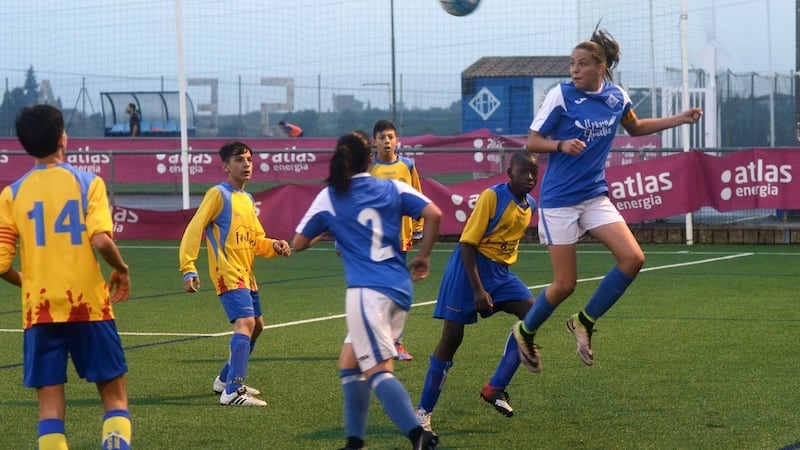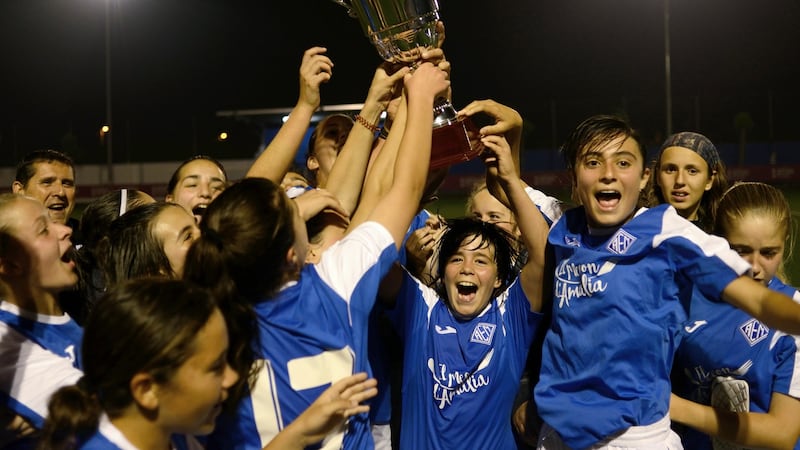The ponytailed forward cut through the rain and the defence and drove a low shot past the outstretched arm of the goalkeeper.
The pinpoint strike – her 38th of the season – confirmed Andrea Gómez as the top scorer for her title-winning team.
The boys Gómez left in her wake, though, were not the first ones forced to retrieve one of her shots from their net. Gómez (13) and her team-mates had been confounding boys all season, playing so well that their girls’ team recently won a junior regional league in Spain, beating 13 boys’ teams in the process.
“I always try to show that soccer isn’t just for boys,” Gómez said. “If you’re technically better, you can compensate for being perhaps physically weaker.”
In the United States and a handful of other countries, it is not uncommon for women to upstage their male counterparts when it comes to soccer success. But in Spain, women’s soccer, despite the country’s first Women’s World Cup appearance in 2015, remains a sideshow.
Spain’s top women’s league did not sign its first major corporate sponsorship deal until last summer – three decades after the league began – and the country’s most successful club, Real Madrid, does not have a women’s team.
Gómez plays for an amateur club, AEM Lleida, that decided almost a decade ago to focus on coaching girls. In 2014, coming off another season in which its girls dominated other girls’ teams, AEM registered one of its teams in a boys’ league for the first time.
“To push these girls, we felt they had to play against boys because you need strong opponents to make real progress,” said José María Salmerón, the club’s general director.
Mixed teams
AEM took advantage of a Spanish soccer federation rule that allows clubs to field players of any sex – including mixed teams that combine boys and girls – for junior league competitions until age 14.
Back then, not everyone was convinced the decision was a wise one. “A few parents called us crazy when we registered the team,” said Sergio González, AEM’s president. “If this had gone very wrong, we would have been held responsible for humiliating the girls.”

The transition was not easy. The girls finished 12th in an 18-team league in their debut season. But as the team improved, and began to beat boys’ teams with more regularity, its progress generated unpleasant reactions.
“It’s really been more a problem for parents rather than their boys,” Salmerón said of comments directed at the team during matches. “It’s strange, but most of the macho comments and insults have come from the mothers of some of the boys we play.”
It is not just opponents who have struggled to adapt, however. Daniel Rodrigo, the AEM coach, recalled a recent match when the referee asked him before kickoff whether his team had not travelled to the wrong field.
During another match, the referee upset the AEM players by regularly referring to them as “las princesas” – the princesses – while he directed play.
In AEM’s final home game, Gómez led her team past its toughest rival this season, the boys from La Noguera, a club from about 12 miles away. La Noguera fields teams in different age groups from an overall squad of 113 players. Only one of them, a seven-year-old, is a girl.
“We just don’t have a tradition of girls,” said Pere Clarisó, La Noguera’s technical director. He highlighted AEM’s superior discipline as one reason for its success.
‘It’s hard to lose against girls’
“Tactically, you can see that these girls listen to every word from their coach,” he said. “They really try to do as they’re told.”
After the match, the AEM girls celebrated their title by tossing Rodrigo into the air and holding up their trophy as the stadium loudspeakers blared We Are the Champions.
The boys from La Noguera looked dejected but were quick to offer praise, too. “It’s hard to lose against girls,” said one player, Oriol Marchal. “But these ones really are very good.”

AEM officials said they were planning to use this season’s success to start a crowdfunding campaign that the club hopes will raise about $10,000 for its coaching programme.
The extra money is needed, the officials said, because the Spanish soccer federation provides little support for grassroots girls’ soccer, and because the club has been unable to persuade any company to come aboard as a sponsor.
“Women have made real progress, which is amazing when you look at the big difference in how the money is allocated,” González said.
But unequal treatment persists. In youth soccer, he said, “I know some clubs that only use their vehicles to transport their boys; the girls have to fend for themselves.”
Inside the club, initial objections faded once the team showed it could outplay boys teams. Ana Maria Biela acknowledged that she had been reluctant to allow her daughter, Cristina, to play matches when she was younger, especially against boys.
Accomplishments
“I delayed as long as possible because I was afraid that she would get hurt by the boys,” Biela said. “She kept answering that she could also hurt boys.”
Now Biela and other parents are revelling in their daughters’ accomplishments, and the team’s success has helped increase the club’s female membership to more than 25 per cent of its overall number of players, the largest ratio in Lleida province in northeastern Spain.
“They are young, so they aren’t perhaps aware that they’ve done something quite extraordinary,” Biela said.
Gómez, the captain and top scorer, said that she was proud her team helped promote the image of women’s soccer in Spain, even if her own ambition is to move eventually to the United States to play there instead.
“I want to play where women’s soccer is really valued,” she said. “The paradise is in the United States – not here, unfortunately.”
– (New York Times service)











